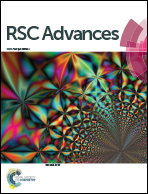Intracellular delivery of CII TA genes by polycationic liposomes for suppressed immune response of dendritic cells†
Abstract
MHC II transactivator (CII TA) protein is a requisite for the expression of major histocompatibility complex class II (MHC II) proteins which are principal mediators of immune response. Construction of an effective nanocomplex to suppress expression of CII TA proteins can be a potential strategy for inhibiting unwanted immune response. In this work, a nanocomplex was designed by incorporating pCIITA (CII TA genes within a plasmid) into the polycationic liposomes with an optimal mass ratio at 1 : 2. The monodisperse nanocomplexes possessed spherical shape and uniform size. Results of cells transfection showed that the nanocomplexes displayed an enhanced ability of intracellular delivery than that of naked pCIITA. Expression of CII TA and MHC II proteins were significantly decreased in the transfected cells. Furthermore, the in vitro immune response model based on mixed lymphocyte culture experiment confirmed that the nanocomplexes successfully inhibited immune response of dendritic cells (DCs) through intracellular delivery of CIITA genes. All the results suggested this approach has a great potential in suppression of unwanted immune responses, which relates to many immune diseases.


 Please wait while we load your content...
Please wait while we load your content...